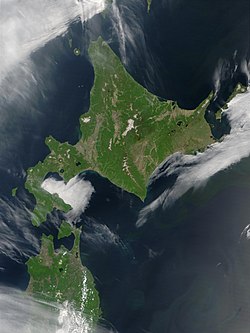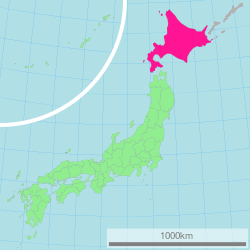
Back Hokkaido ACE Hokkaido Afrikaans ሆካይዶ Amharic Hokkaido ANG هوكايدو Arabic هوكايدو ARY هوكايدو ARZ হোক্কাইডো Assamese Hokkaidō AST Hokkaydo Azerbaijani
Hokkaidō
北海道 | |
|---|---|
Prefecture and region | |
| Japanese transcription(s) | |
| • Japanese | 北海道 |
| • Rōmaji | Hokkaidō |
 Satellite image of Hokkaido by Terra, May 2001 | |
| Anthem: Hikari afurete, Mukashi no mukashi and Hokkai bayashi | |
 | |
| Coordinates: 43°N 142°E / 43°N 142°E | |
| Country | Japan |
| Region | Hokkaidō |
| Island | Hokkaidō |
| Capital | Sapporo |
| Largest city | Sapporo |
| Subdivisions | Districts: 74, Municipalities: 179 |
| Government | |
| • Governor | Naomichi Suzuki |
| Area | |
| • Total | 83,423.84 km2 (32,210.12 sq mi) |
| • Rank | 1st |
| Population (July 31, 2023) | |
| • Total | 5,111,691 |
| • Rank | 8th |
| • Density | 61/km2 (160/sq mi) |
| GDP | |
| • Total | JP¥ 20,465 billion US$ 187.7 billion (2019) |
| ISO 3166 code | JP-01 |
| Website | www |
| Symbols of Japan | |
| Bird | Tanchō (red-crowned crane, Grus japonensis) |
| Flower | Hamanasu (rugosa rose, Rosa rugosa) |
| Mascot | Kyun-chan (キュンちゃん) |
| Tree | Ezomatsu (Jezo spruce, Picea jezoensis) |
Hokkaido (Japanese: 北海道, Hepburn: Hokkaidō, pronounced [hokkaꜜidoː] , lit. 'Northern Sea Circuit') is the second-largest island of Japan and comprises the largest and northernmost prefecture, making up its own region.[2] The Tsugaru Strait separates Hokkaidō from Honshu; the two islands are connected by the undersea railway Seikan Tunnel.
The largest city on Hokkaido is its capital, Sapporo, which is also its only ordinance-designated city. Sakhalin lies about 43 kilometres (27 mi) to the north of Hokkaidō, and to the east and northeast are the Kuril Islands, which are administered by Russia, though the four most southerly are claimed by Japan. The position of the island on the northern end of the archipelago results in colder climate, with the island seeing significant snowfall each winter. Despite the harsher climate, it serves as agricultural breadbasket for many crops.
Hokkaido was formerly known as Ezo, Yezo, Yeso, or Yesso.[3] Although Japanese settlers ruled the southern tip of the island since the 16th century, Hokkaido was primarily inhabited by the Ainu people.[4] In 1869, following the Meiji Restoration, the entire island was annexed by Japan and renamed Hokkaido.[5][6][7] As a result, Japanese settlers dispossessed the Ainu of their land and forced them to assimilate.[4][5] In the 21st century, the Ainu are almost totally assimilated into Japanese society; as a result, many Japanese of Ainu descent have no knowledge of their heritage and culture.[8][9][10]
- ^ "2020年度国民経済計算(2015年基準・2008SNA) : 経済社会総合研究所 - 内閣府". 内閣府ホームページ (in Japanese). Retrieved 2023-05-18.
- ^ "離島とは(島の基礎知識) (what is a remote island?)". MLIT (Ministry of Land, Infrastructure, Transport and Tourism) (in Japanese). Ministry of Land, Infrastructure, Transport and Tourism. 22 August 2015. Archived from the original (website) on 2007-11-13. Retrieved 9 August 2019.
MILT classification 6,852 islands (main islands: 5 islands, remote islands: 6,847 islands)
- ^ Nussbaum, Louis-Frédéric. (2005). "Hokkaidō" in Japan Encyclopedia, p. 343, p. 343, at Google Books
- ^ a b Seaton, Philip (2017). "Japanese Empire in Hokkaido". Oxford Research Encyclopedia of Asian History. doi:10.1093/acrefore/9780190277727.013.76. ISBN 978-0-19-027772-7.
- ^ a b Jolliffe, Pia M. (15 October 2020). "Forced Labour in Imperial Japan's First Colony: Hokkaidō". The Asia–Pacific Journal. 18 (20).
- ^ "How the Sharing of Ainu Culture Became One Man's Lifework|Features|HOKKAIDO LOVE! -Hokkaido Official Tourism Site". 15 July 2023.
- ^ https://www.hm.pref.hokkaido.lg.jp/wp-content/themes/hokkaidomuseum/images/forign_pdf/ENG-2-4.pdf
- ^ Cobb, Ellie (20 May 2020). "Japan's forgotten indigenous people". BBC Travel. Retrieved 29 December 2023.
- ^ Honna, Nobuyuki; Tajima, Hiroko Tina; Minamoto, Kunihiko (2000). "Japan". In Kam, Ho Wah; Wong, Ruth Y. L. (eds.). Language Policies and Language Education: The Impact in East Asian Countries in the Next Decade. Singapore: Times Academic Press. ISBN 978-9-81210-149-5.
- ^ Hohmann, S. (2008). "The Ainu's modern struggle". World Watch. 21 (6): 20–24.

